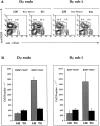Regulation of B lymphocyte development by the truncated immunoglobulin heavy chain protein Dmu
- PMID: 9480980
- PMCID: PMC2212169
- DOI: 10.1084/jem.187.5.703
Regulation of B lymphocyte development by the truncated immunoglobulin heavy chain protein Dmu
Abstract
The development of B lymphocytes from progenitor cells is dependent on the expression of a pre-B cell-specific receptor made up by a mu heavy chain associated with the surrogate light chains, immunoglobulin (Ig)alpha, and Igbeta. A variant pre-B cell receptor can be formed in which the mu heavy chain is exchanged for a truncated mu chain denoted Dmu. To investigate the role of this receptor in the development of B cells, we have generated transgenic mice that express the Dmu protein in cells of the B lineage. Analysis of these mice reveal that Dmu expression leads to a partial block in B cell development at the early pre-B cell stage, probably by inhibiting VH to DHJH rearrangement. Furthermore, we provide evidence that Dmu induces VL to JL rearrangements.
Figures





Similar articles
-
Truncated immunoglobulin Dmu causes incomplete developmental progression of RAG-deficient pro-B cells.Mol Immunol. 2002 Jan;38(7):547-56. doi: 10.1016/s0161-5890(01)00085-2. Mol Immunol. 2002. PMID: 11750656
-
Immunoglobulin gamma 2b transgenes inhibit heavy chain gene rearrangement, but cannot promote B cell development.J Exp Med. 1993 Dec 1;178(6):2007-21. doi: 10.1084/jem.178.6.2007. J Exp Med. 1993. PMID: 8245779 Free PMC article.
-
Multiple levels of selection responsive to immunoglobulin light chain and heavy chain structures impede the development of Dmu-expressing B cells.J Immunol. 2008 Sep 15;181(6):4098-106. doi: 10.4049/jimmunol.181.6.4098. J Immunol. 2008. PMID: 18768866
-
Control of the sizes and contents of precursor B cell repertoires in bone marrow.Ciba Found Symp. 1997;204:172-82; discussion 182-6. doi: 10.1002/9780470515280.ch12. Ciba Found Symp. 1997. PMID: 9107420 Review.
-
Repertoire selection by pre-B-cell receptors and B-cell receptors, and genetic control of B-cell development from immature to mature B cells.Immunol Rev. 2000 Jun;175:33-46. Immunol Rev. 2000. PMID: 10933589 Review.
Cited by
-
Mouse Antibody of IgM Class is Prone to Non-Enzymatic Cleavage between CH1 and CH2 Domains.Sci Rep. 2018 Jan 11;8(1):519. doi: 10.1038/s41598-017-19003-4. Sci Rep. 2018. PMID: 29323348 Free PMC article.
-
Receptor selection in B and T lymphocytes.Annu Rev Immunol. 2000;18:19-51. doi: 10.1146/annurev.immunol.18.1.19. Annu Rev Immunol. 2000. PMID: 10837051 Free PMC article. Review.
-
Rearrangement and expression of immunoglobulin light chain genes can precede heavy chain expression during normal B cell development in mice.J Exp Med. 1999 Jan 4;189(1):75-88. doi: 10.1084/jem.189.1.75. J Exp Med. 1999. PMID: 9874565 Free PMC article.
References
-
- Tonegawa S. Somatic generation of antibody diversity. Nature. 1983;302:575–581. - PubMed
-
- Pillai S, Baltimore D. Formation of disulphide-linked μ2 ω2 tetramers in pre–B cells by the 18K ω-immunoglobulin light chain. Nature. 1987;329:172–174. - PubMed
-
- Sakaguchi N, Melchers F. λ5, a new light-chain– related locus selectively expressed in pre–B lymphocytes. Nature. 1986;324:579–582. - PubMed
Publication types
MeSH terms
Substances
LinkOut - more resources
Full Text Sources
Research Materials

